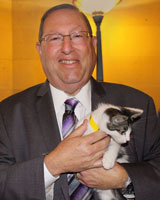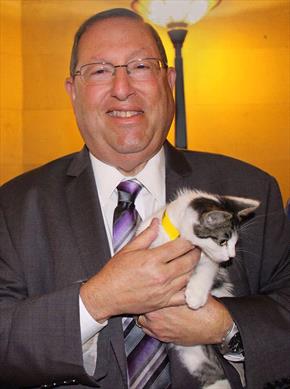!This story has an important update


Facebook photo
Los Angeles City Council Member Paul Koretz began a push to criminalize cat declawing in California in 2003, when he served on the California State Assembly. The California Veterinary Medical Association fought the initiative, which ultimately failed, but not before Kortez helped pass anti-declaw ordinances in at least two cities. To date, seven cities in California have made it a crime to declaw cats. Lawmakers are considering whether to enact such a ban statewide.
A bill to criminalize declawing cats will be heard today by California Senate Public Safety Committee. If enacted, SB 1441 would impose the nation's first statewide ban on the controversial surgical procedure.
Introduced by Sen. Henry Stern, the bill adds "domestic cats" to section 597.6 of the Penal Code of California, which already bans the surgical declaw of exotic or wild native cat species. Under the proposed amendment, veterinarians performing the procedure, which involves the partial amputation of a cat's toe bones, could be charged with a misdemeanor punishable by up to a year in prison and/or $10,000 fine. Any person who arranges for the surgery could face the same penalties.
Advocates of the ban believe that declawing a cat causes the animal pain and may result in lameness and behavioral problems. Many consider it a form of animal cruelty.
California Veterinary Medical Association disagrees. It asserts that feline onychectomy — the medical term for declaw procedures — can be performed humanely and should be preserved as a last-resort option for owners who otherwise would euthanize or abandon their cats. Declawing is typically sought by owners when a cat's scratching behavior is destructive to property or causes injuries, particularly to those who are immune compromised. Anti-declaw advocates counter that scratching is a natural feline behavior and non-surgical solutions exist to curb it, such as behavior modification, nail trimming, synthetic nail caps and the use of suitable scratching implements.
CVMA officials assert that the enactment of SB 1441 would demonstrate that activists have authority over the practice of medicine, which is the purview of regulators.
"On the surface, you may think this bill is only about the declaw procedure," CVMA officials said in an action alert to members. "In reality, it criminalizes a legal veterinary surgical procedure and accuses veterinarians and their clients of animal cruelty."
Cat declawing has been a subject of discussion and controversy at the state Capitol since 2003, when then-Assembly Member Paul Koretz, a Democrat representing the 42nd district, introduced legislation conceptually similar to SB 1441. While lawmakers rejected Koretz's bill, officials in West Hollywood, where he once was mayor, took up the cause. On April 7, 2003, the West Hollywood City Council unanimously adopted the nation's first ordinance to ban the procedure. (The ordinance makes an exception for therapeutic purposes such as removal of infected or injured tissue.)
The West Hollywood ordinance states that the "mere convenience of the onychectomy (declawing) and/or flexor tendonectomy procedures to the pet's guardian does not justify the unnecessary pain, anguish and permanent disability caused [to] the animal.'' CVMA challenged the ordinance in court, contending that it was illegal for a municipality to outlaw a medical procedure that's sanctioned and regulated by the California Veterinary Medical Board (CVMB).
"We just want to make sure [city officials] can't decide what we do in medical practice," CVMA Executive Director Valerie Fenstermaker told the VIN News Service.
Contentious backstory
CVMA ultimately lost its battle against West Hollywood in October 2007, when the state Supreme Court refused to consider a petition to review a decision by the California Courts of Appeal, which upheld the city's right to make declawing cats a crime. The appellate court ruling overturned a verdict by Superior Court Judge James Bascue on Nov. 30, 2006, which declared West Hollywood's ordinance to be "unlawful, invalid and unenforceable."
Following the state Supreme Court's rejection, copycat declaw bans spread. To date, at least seven California municipalities, including Los Angeles (where Koretz now serves on the city council) and San Francisco, have passed bans on elective declawing.
The anti-declaw push — led by the Paw Project, a nonprofit founded by Dr. Jennifer Conrad, a veterinarian who advocates against cat declawing — has spread beyond the Golden State to Denver, where city officials passed an ordinance in November to criminalize declaw procedures. Citing welfare concerns, Denver City Council adopted the ban unanimously despite heavy opposition from the Colorado Veterinary Medical Association, which asserted that veterinarians and cat owners should be left to make such medical decisions.
The movement also has gained traction in New Jersey, New York, Rhode Island and Hawaii, where declaw bans have come before state legislatures. So far, all have stalled or flopped, but advocates persist. When in 2016 a bill to add feline onychectomy to the state's criminal animal-cruelty offenses did not pass, Rick Alampi, executive director of the New Jersey Veterinary Medical Association, quipped, "There's no doubt in my mind it will reappear in the next session."
Sure enough, a similar measure was introduced in New Jersey in January 2017. It was carried over to 2018, where it's listed as "pending" in the New Jersey Senate Economic Growth Committee. It's companion bill, A 347, is pending in the Assembly Agriculture and Natural Resources Committee.
In California, the Senate committee hearing on SB 1441 today is expected to draw testimony from experts on both sides of the issue. On the "no" side will be officials from the CVMB and CVMA, whose membership of 7,800 includes veterinarians, technicians and students.
In a letter dated April 4 to Sen. Nancy Skinner, the committee's chairperson, CVMA lobbyists Michael and Christina Dillion point out that the penal code change outlined in SB 1441 is designed to circumvent the state Business and Professions Code. In response to the West Hollywood declaw ordinance, the California Legislature amended the state's Business and Professions Code in 2009 to specify that municipalities could not bar state-licensed professionals from performing procedures that fall within the "professionally recognized scope of practice."
While the amendment barred municipalities from adopting future declaw restrictions, it included a grandfather clause that exempted local bans that already existed, including West Hollywood's ordinance. "At the time, there wasn't an opportunity to undo that," Fenstermaker recalled.
The CVMA lobbyists also assert that the passage of SB 1441 would send a message to activists, inviting them to campaign against other medical procedures. "We wonder what procedure would be next to be placed in the penal code — spay and neuter procedures, or even those pertaining to human surgeries ..."
By phone, Fenstermaker added, "This bill certainly sets a precedent for allowing any group to make medical decisions for the public."
Professional opinions
While national veterinary medical organizations address declawing cats via a variety of positions, none support making feline onychectomy a crime. The American Association of Feline Practitioners issued a strong anti-declaw statement in 2017 that called the procedure "ethically controversial" and "NOT medically necessary procedure for cats in most instances."
The AVMA policy "Declawing of Domestic Cats" is more flexible. It states that decisions about whether to declaw a cat should be made by the owner and his or her veterinarian — not legal mandate. Feline onychectomy, the policy says, should be considered "only after attempts have been made to prevent the cat from using its claws destructively or when its clawing presents an above normal health risk to its owners."
The assertion by anti-declaw advocates that declawed cats are more likely to be euthanized, abandoned or relinquished due to post-surgery behavior problems is unfounded, the AVMA policy continues: "There is no scientific evidence that declawing leads to behavioral abnormalities when the behavior of declawed cats is compared with that of cats in control groups."
The CVMA letter notes that advanced surgical techniques and pain management have helped to reduce patient discomfort and recovery time.
"If a client is unable to obtain this surgical procedure from a veterinarian, the client faces tremendous personal conflict of deciding whether to declaw a cat or relinquish that cat to an already-overburdened animal shelter, where it may be euthanized," the letter reads. "This is an untenable situation for an owner, particularly an owner who may be undergoing treatment and cannot afford to risk infection brought on by a cat scratch."
The letter stated that declawing cats isn't a procedure that most veterinarians regularly perform, and the decision to declaw a cat "isn't made lightly." AAFP, AVMA and CVMA policies call on veterinarians to educate clients about the procedure, its benefits and risks, and counsel them on declaw alternatives.
Update: California Senate Public Safety Committee rejected SB 1441. The bill did not make it out of the committee. In October 2021, the California Veterinary Medical Association changed its stance on feline onychectomy with a revised policy that "discourages" the elective procedure.